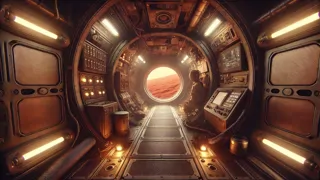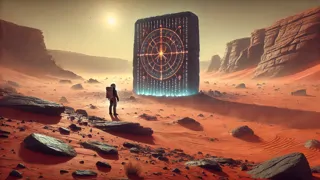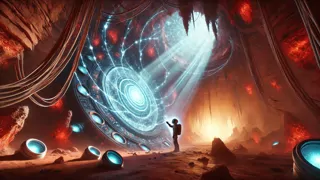Introduction
Under the burning haze of a Martian dawn, I clung to the exterior hull of the Aries Water Reclaimer with gloved fingers numb from cold and adrenaline alike. Months of surveillance and stolen credentials had led me here, pressed against riveted plates beneath flood lamps that vanished in the crepuscular glow. Every vibration sang through my bones as I navigated the maze of maintenance conduits, attuned to the shifting patterns of security drones patrolling overhead. My breath came in ragged gasps, each inhale tasting of recycled air and hydraulic oil. I leaned into an angled seam, cracking it open with a slender tool that squealed against rusted metal, praying the motion sensors remained blind to my presence. Inside the cramped crawlspace lay dormant circuits and flickering monitors, the heartbeat of a mission that promised to take humanity beyond Earth’s cradle. Sweat beaded at my temples as I squeezed through the narrow gap, clutching a salvaged datapad that held the key to unauthorized entry. Behind me, the engines throbbed in silent readiness. I forced myself onward, two hatches away from an odyssey that would test every limit of my resolve, destined to unlock secrets buried beneath scarlet sands.
Clandestine Boarding and Descent
The amber glow of flood lamps at Launch Complex Nine cut through the pre-dawn desert haze, illuminating the massive frame of the Aries Water Reclaimer module. Under cover of early morning stillness, I slipped through a gap in the security fencing, muscles tensed as I navigated the labyrinth of fuel hoses and catwalks. Months of stolen access codes and late-night surveillance had led to this moment. My breath came fast. Somewhere above me, spotlights scanned the salt flats while guards lounged in their watchtowers, unaware I was inches away. Sweat beaded at the nape of my neck though the desert air remained cool. I honed in on a maintenance hatch and drew out a fine-cut glide bar, silently prying open the panel to expose a tangle of circuits. One wrong move, and alarms would shriek through the base. With gloved hands, I wove through the wiring like a shadow. I keyed in a sequence I’d cracked from internal logs and felt the lock disengage. A faint hiss signaled the entry point gave way, and I crawled inside the belly of the spacecraft. My pulse hammered as I retreated deeper into the narrow crawlspace, aware that every second counted against me.

In the cramped interior, wires rattled with every passing moment as energy coursed through the hull around me. The temperature gauge on a nearby panel glowed green, but the air stayed frigid, forcing me to squeeze deeper into the bowels of the landing stage. Each breath felt recycled, damp with the tang of hydraulic fluid and charged particles. I stretched out a hand to steady myself against a row of fuel lines, marveling that nothing so far had triggered the internal motion sensors. The vibration of the booster’s ignition thrusters hummed through the metal spine of the craft, sending shivers along my forearms. I clutched an insulated patchwork of spare fabric I’d stitched into my jacket, hoping it would mask any heat signatures. The soft beep of countdown data pinged in unison with my heartbeat. Over the comm speaker, I could faintly make out Flight Director Shaw barking orders, oblivious to the clandestine hitchhiker in their midst. My stomach knotted as I realized that the next impulse would hurl me into a vacuum filled only with the endless black of space. There was no turning back. Above the roar of engines, hope and terror wrestled for dominance in my mind, neither willing to concede as ambition pushed me forward.
As the countdown reached zero, the booster flared to life in a thunderous exhalation of flame, shaking me loose from my makeshift foothold and slamming me against a cluster of sensor arrays. The metal groaned like a living creature as it strained against gravity’s pull. Pain seared through my shoulder as I tumbled past illuminated gauges, but adrenaline carried me onward. Through a flimsy viewport along the hull, I caught a glimpse of Earth slipping away behind a swirl of cloud cover and fading blue atmosphere. Pressurized jets roared, sending the craft beyond the reach of air, into a realm where only radios and cold circuitry could signal presence. My makeshift shelter inside a maintenance bay shuddered as the main stage separated, and I felt the vacuum claw at me through every crevice of the hatch. Panic rippled when I thought the external integrity might falter, but steel and titanium held strong. My earplugs compensated for the sudden silence, replaced by the muffled hum of backup power nodes. I pressed my palm to the wall, heart thrumming in my ears, and whispered a silent vow: when I finally set foot on Mars, it would all be worth it. The ship drifted toward the distant red planet, a dormant giant ready to awaken under Martian gravity.
Days passed in a blur of weightlessness, each microgravity cycle tinting the stale air with dust distilled from the life support scrubbers. I rationed a supply of recycled water and protein bars, too terrified to reveal myself. Every toe curl or finger twitch sent my heart racing, fearing a stray engineer’s shadow might uncover me. Solar panels shimmered outside and a muted orange glow pervaded the forward section as the craft nudged its trajectory toward Mars orbit. I studied the orbital insertion diagrams etched into a control board, marveling at the precision required to slip past the planet’s Van Allen belts unscathed. The automated navrings hummed, aligning thrusters for deorbit burn, and I placed my ear against a sealed valve to feel the cadence of the spacecraft’s heartbeat. Anxiety tugged at the edge of my thoughts as unknown variables loomed, but determination hardened in my chest. If I survived that burn, a second hatch opening would let me slip onto the descent stage like a ghost in the machine. I rehearsed the sequence in my mind. When final separation occurred, I would cling to the outer skin until the lander plunged through the dusty atmosphere.
As the deorbit servos activated, the craft pitched nose-first toward Mars, skeletal thrusters popping to correct the angle with surgical precision. Rumble quaked through the hull plating, heralding the descent stage’s separation. My breath caught when I saw the dusty glow of the Red Planet’s upper atmosphere through a tiny panel crack, wisps of red-brown swirling below. A low-frequency roar washed over me as the landing cones ignited—a harsh, burning torrent slicing through the thin Martian air. I forced every muscle to clamp onto a fusion-welded strut, hissing as the heat tiles scorched at the edge of my vision. Light flared in the darkness, then gave way to a relentless twilight that bathed the rocky surface in shadows. Below, I could almost trace canyons and crater rims forming intricate patterns across the plains. It felt like the first moment of creation, fragile and terrifying, offering no grace period for mistakes. Instruments ticked down the final seconds to touchdown. And then, with a thunderous jolt that rattled my bones, the lander kissed the rust-red ground, burying its feet in fine silt. For a moment, silence ruled once more.
Echoes of Ancient Ruins
The first rays of Mars’ pale sun seeped through my visor as I pried open the outer hatch of the descent stage, stepping onto a landscape sculpted by millennia of wind and dust. Beneath my boots, the regolith shifted like a bed of crushed brick, leaving footprints that would vanish with the next whisper of wind. I activated my heads-up display and scanned for heat signatures, black against the cold horizon. The craft’s golden footpads glowed in the dull light, a testament to human engineering daring to defy the void. My breath in the sealed suit came in shallow rhythms as I circled the lander, inspecting for any signs of damage sustained during descent. Silence dominated the barren plains save for the whisper of oxygen circulating behind me. Beyond the landing site, a series of low ridges rose into the haze, ancient dunes marking the outskirts of a broad basin. My skin prickled at the knowledge that centuries ago, no human had set foot here. Every sensor reading felt like a secret waiting to be unlocked in this alien domain. I knelt to trace a crack in a shard of heat-resistant glass, the only human artifact scattered in this untamed world, and felt a ripple of anticipation.

With cautious strides, I ventured toward the looming ridges, each footfall tracked by satellites and ground sensors I had no right to access. The gravity here was a delicate weight, light enough to prolong each landing but heavy enough to remind me I could falter with a single misstep. Dust devils spun on the horizon, twisting scarlet plumes into the thin air, while faint electromagnetic readings pulsed from below the surface. My crosshairs flicked across the HUD as I followed anomalies that hinted at subsurface cavities. I tapped the suit’s boots to activate seismic sensors, listening for echoes of empty chambers hidden beneath the dunes. Patterns emerged in the shifting sands—subtle depressions that read like pages of a long-forgotten text. Adrenaline sharpened my senses when I spotted angular edges jutting from the ground, square and unnatural against the rolling dunes. Heart pounding, I crouched behind a rocky outcrop, peering at stone blocks arranged in a half-buried formation. Ancient carvings etched in relief glinted under the Martian glare, their meaning eluding me yet stirring a deep, resonant curiosity. Mars had revealed a glimmer of its hidden history, far older than any human endeavour could claim.
Approaching the monolith, I cycled through my limited library of field linguistics, searching for symbolic echoes that might translate the strange glyphs before me. The carvings wove spirals and lines that pulsated with faint bioluminescence at the edges, as if annealed into the stone through immeasurable time. I reached out a gloved hand, hesitating when the hairs on the back of my neck pricked in warning. A static charge thrummed through the suit, and I felt the ground tremor beneath me, subtle but undeniable. Mapping dials on my wrist flickered, registering high levels of exotic radiation undetected by mission control. Shadows deepened in the cracks, glowing deeper shades of purple and amber. I ducked back instinctively when a low hum vibrated in my eardrums, like the echoes of a distant storm. The monolith, half-buried in dunes, seemed to pulse with living intent, beckoning me to decipher its secrets. Sweat steamed inside my suit as I adjusted the helmet’s visor to a tighter seal, sealing out the unseen energy. My mission objective—unauthorized though it remained—shifted in importance, eclipsed by the imperative to understand this alien design. Every instinct told me I was no longer exploring but trespassing on something far older than any human mind.
I set down a portable lidar drone beside the monolith, activating its rotors and fancying myself an archaeologist from Earth, though the designation felt laughable. The drone’s whirring blades scattered Martian dust in erratic arcs before steadying a foot above the ground. Beams of infrared light lanced into the carvings, illuminating strata beneath layers of sediment accrued over millennia. Data streamed to my control pad, building a three-dimensional map that revealed door-like indentations on one side of the stone slab. The shapes were symmetrical yet alien, hinting at engineering far beyond my comprehension. I marked the coordinates and planned a longer excavation after nightfall, when lower temperatures might prick the stone into revealing hidden entrances. My glove tapped the comm unit, but static greeted me, the storm front on the horizon interfering with long-range channels. I tucked the control pad into an outer pocket, heart heavy with the realization that I might be alone in this discovery. The wind picked up, rattling the flight jacket I’d pressed close, and the sky turned a bruise-purple as evening approached. Under that settling darkness, the monolith seemed to whisper promises of revelations older than human myth.
Night on Mars fell with a crystalline clarity that revealed a sky strewn with pale stars, untempered by Earth’s thick atmosphere. I lit a temporary lantern near the monolith, its pale blue glow casting eerie shadows across the etched glyphs. Tools clinked as I cleared away granular sediment, revealing the outline of a hatch. My gloved hand pondered the control seals, decayed but still intact, as though the builders had anticipated my arrival. In the hush of alien night, I aligned the connectors on my suit’s power pack with faint reliefs on the hatch frame. A pulse of energy surged forth, and the monolith answered with a soft clicking chatter. Lines of light traced pathways along the stone and into the ground, illuminating a subterranean corridor that yawned at my feet. Every hair on my arms raised as the threshold beckoned, an invitation to cross into history’s most profound unknown. With trembling resolve, I swallowed fear and stepped forward into the darkness.
Revelation and Return
Inside the narrow corridor, the airlock’s threshold hissed as I crossed into a chamber studded with alien glyphs and crystalline conduits. The walls glimmered under the beam of my helmet lamp, reflecting prismatic patterns onto every surface. A delicate network of veins pulsed with an otherworldly glow, as if the stone itself breathed with latent energy. My boots echoed across the smooth ground, leaving prints in a fine dust that behaved like powdered metal. I paused under a vaulted ceiling carved in fractal geometry, heart pounding at the realization that this was no empty monument but a functional craft of some bygone civilization. Samples of luminescent moss clung to joints, defying the planet’s desiccating winds, and I knelt to study microscopic structures that pulsed beneath the surface. The corridor branched into a triad of tunnels, each guarded by bifurcated doors adorned with symbols that hinted at purpose—archive, sanctum, vessel. My HUD registered fluctuating energy readings, climbing steadily with every step I took deeper into the chamber. With deliberate caution, I placed a data beacon near an arc of inscriptions, allowing it to record the patterns for later transmission. I drew a deep breath and advanced toward the central archway, driven by a mixture of scientific fervor and primal awe.

As I reached the central hub, a vast circular dais unfolded before me, etched with concentric rings of symbols that gestured toward the cosmos. Steps carved from obsidian granite spiraled inward, guiding me to a pedestal crowned with a device of impossible complexity. It resembled an orb of translucent alloy, cradled by metallic spines that flexed and contracted like a living skeleton. I raised my data pad and traced the orb’s surface, watching subatomic vibrations dance across its skin. Diagrams within my stolen archives flickered to life in my mind as I matched patterns to theoretical frameworks on hyperdimensional travel. The hull hummed under my gloves, resonating with chords that transcended my understanding of sound. Activation panels glowed in sequence as if recognizing my presence, aligning to physiological signatures in my suit. I felt a surge of vertigo, a phantom resonance as the energies aligned. Images flickered in my vision—galaxies spiraling in impossible angles, doorways to worlds draped in emerald clouds. My breathing grew shallow, claustrophobia threatening to close in as the orb responded to the ambient energy of the Martian night.
Before I could fully grasp its purpose, the airlocks ahead slammed shut with a thunderous crack, sealing the chamber in an eerie stasis. Alarms—silent on Earth—screeched in the resonant frequencies of the stone, shaking my entire frame. Beams of concentrated light arched from hidden conduits, crisscrossing the air like silent sentinels. The orb on the pedestal pulsed fiercely, sending ripples of blue-white energy across the chamber floor. My HUD flashed a critical warning as auxiliary conduits overheated, venting ionized gas into the corridor. Panic flared inside my chest as I realized I had triggered a defensive protocol, one designed to quarantine intruders rather than welcome them. I backed away instinctively, but a low rumble resonated beneath my boots—a structure-wide tremor that threatened to collapse the cavern above. My comm link cracked again with static, severing my tenuous hope of calling for help. I sprinted for the archway, adrenaline searing through my limbs, but my suit alerted me to a climbing radiation spike. In that moment, I faced the stark truth: this marvel could kill me or transform me in unimaginable ways.
With a desperate flick, I accessed the orb’s data output, coaxing the archive fragments into my neural interlace before my suit’s memory cells overloaded. Images and schematics flooded my vision—star maps, propulsion designs, resonant frequencies calibrated to breach interstellar thresholds. I wrenched my helmet’s display panel down to protect the information, acutely aware that every second here brought a new risk of entrapment. Behind me, the monolith corridor trembled, dust cascading from the ceiling in silent clouds. My rational mind raced through protocols for containment and sample retention, but the decision crystallized in a pulse of clarity: the knowledge here was too vital to leave behind. If mission control learned of this, they’d seal the entire network and bury it under bureaucratic red tape or military lockdown. Better that the world know the truth than lose this chance to rewrite human destiny. With one hand I severed the data beacon, clutching it to my chest, while the other powered up a laser cutter on my belt. I sliced through the inner hatch’s bypass panel, praying the release wouldn’t trigger further reprisals. When the door finally yawed open, I stumbled through and sealed it behind me, holding my breath until the tremors abated.
Emerging back into the cold Martian twilight, I discovered that the sky had shifted to a deeper shade of bruise-purple, stars piercing the heavens in their unblinking assembly. I navigated by compass coordinates toward the original landing craft, clutching the stolen archive like a sacred relic. Every step felt weighted with a mixture of triumph and foreboding, as though I carried not just data but the fate of worlds on my shoulders. Behind the ridges, glowing lights of a supply module beckoned—an unsuspecting habitat orbited by unknowing technicians who still thought they had a lone mission. I bypassed motion sensors I had cracked earlier, slipping inside to revive the communication uplink. By the time engineers realized something was off, I was already sending encrypted packets across the galactic network, ensuring that every signal from the monolith danced into open channels. The antiquated hatch of the supply craft closed, the engines ignited, and I rose from Mars’ soil with the weight of a revelation that could transform humanity forever.
Conclusion
Months after the mission, news of the data beacon’s cosmic signal sparked a global uproar, as scientists from Houston to Beijing scrambled to decipher fragments of an alien ark half-buried beneath Martian dust. What began as a stowaway’s desperate gamble became humanity’s most profound revelation: evidence that we are not alone. Star maps and propulsion schematics recovered from the monolith rewrote textbooks overnight. Rival factions clashed over patents and protocols, while debates raged in councils over the ethics of engaging with technology older than any human design. I slipped away from the frantic scramble, haunted by the orb’s silent hum and promises of doorways to distant worlds. Late at night, I replayed the resonance echoing in my mind, wondering if we had truly unlocked its power or merely awakened something we could not control. Still, the courage to stand on that rust-red surface transformed me, proving that humanity’s destiny lies not in waiting but in daring. Mars opened a chapter of hope and question, an invitation no dreamer can deny.


















